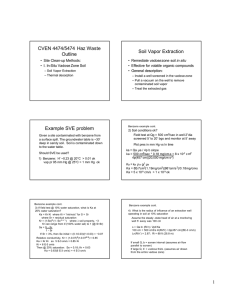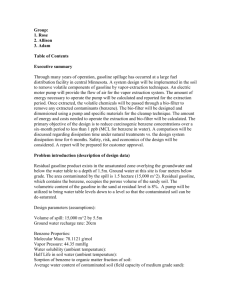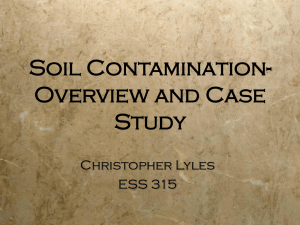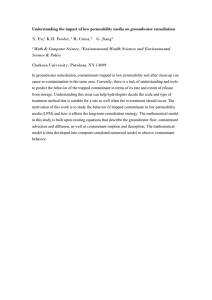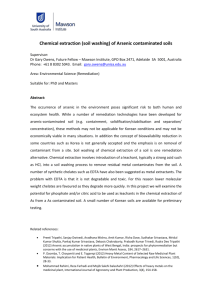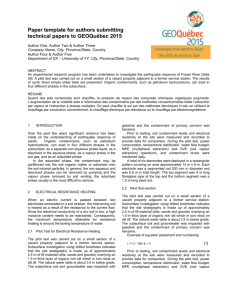Thermally Enhanced Soil Vapor Extraction Closing
advertisement
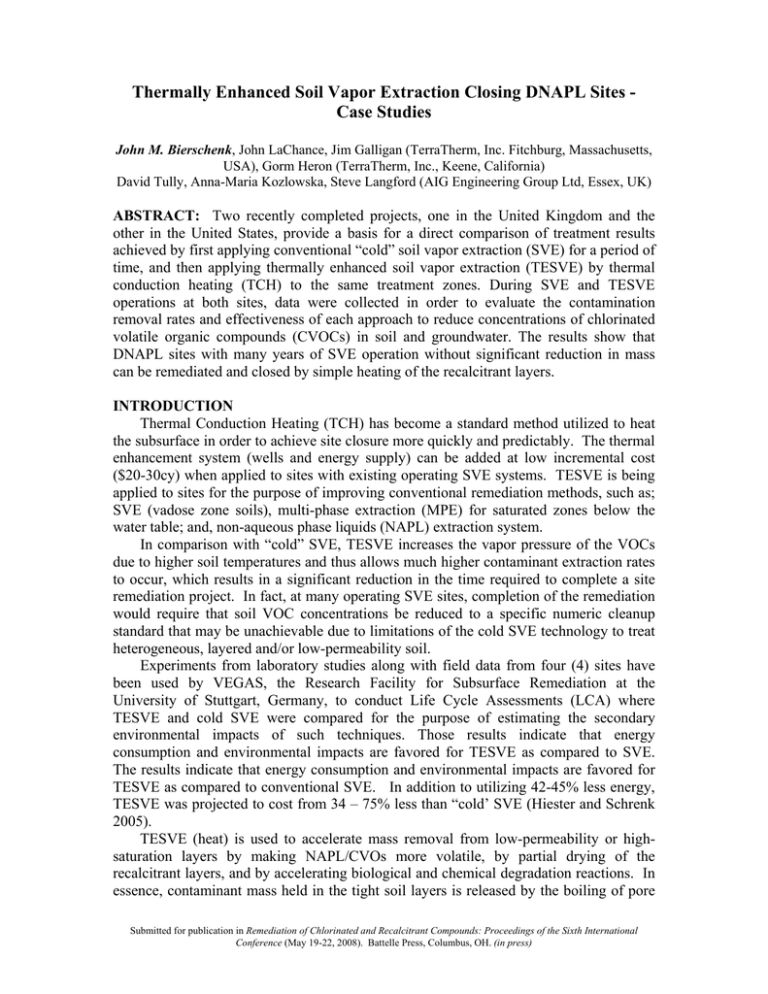
Thermally Enhanced Soil Vapor Extraction Closing DNAPL Sites Case Studies John M. Bierschenk, John LaChance, Jim Galligan (TerraTherm, Inc. Fitchburg, Massachusetts, USA), Gorm Heron (TerraTherm, Inc., Keene, California) David Tully, Anna-Maria Kozlowska, Steve Langford (AIG Engineering Group Ltd, Essex, UK) ABSTRACT: Two recently completed projects, one in the United Kingdom and the other in the United States, provide a basis for a direct comparison of treatment results achieved by first applying conventional “cold” soil vapor extraction (SVE) for a period of time, and then applying thermally enhanced soil vapor extraction (TESVE) by thermal conduction heating (TCH) to the same treatment zones. During SVE and TESVE operations at both sites, data were collected in order to evaluate the contamination removal rates and effectiveness of each approach to reduce concentrations of chlorinated volatile organic compounds (CVOCs) in soil and groundwater. The results show that DNAPL sites with many years of SVE operation without significant reduction in mass can be remediated and closed by simple heating of the recalcitrant layers. INTRODUCTION Thermal Conduction Heating (TCH) has become a standard method utilized to heat the subsurface in order to achieve site closure more quickly and predictably. The thermal enhancement system (wells and energy supply) can be added at low incremental cost ($20-30cy) when applied to sites with existing operating SVE systems. TESVE is being applied to sites for the purpose of improving conventional remediation methods, such as; SVE (vadose zone soils), multi-phase extraction (MPE) for saturated zones below the water table; and, non-aqueous phase liquids (NAPL) extraction system. In comparison with “cold” SVE, TESVE increases the vapor pressure of the VOCs due to higher soil temperatures and thus allows much higher contaminant extraction rates to occur, which results in a significant reduction in the time required to complete a site remediation project. In fact, at many operating SVE sites, completion of the remediation would require that soil VOC concentrations be reduced to a specific numeric cleanup standard that may be unachievable due to limitations of the cold SVE technology to treat heterogeneous, layered and/or low-permeability soil. Experiments from laboratory studies along with field data from four (4) sites have been used by VEGAS, the Research Facility for Subsurface Remediation at the University of Stuttgart, Germany, to conduct Life Cycle Assessments (LCA) where TESVE and cold SVE were compared for the purpose of estimating the secondary environmental impacts of such techniques. Those results indicate that energy consumption and environmental impacts are favored for TESVE as compared to SVE. The results indicate that energy consumption and environmental impacts are favored for TESVE as compared to conventional SVE. In addition to utilizing 42-45% less energy, TESVE was projected to cost from 34 – 75% less than “cold’ SVE (Hiester and Schrenk 2005). TESVE (heat) is used to accelerate mass removal from low-permeability or highsaturation layers by making NAPL/CVOs more volatile, by partial drying of the recalcitrant layers, and by accelerating biological and chemical degradation reactions. In essence, contaminant mass held in the tight soil layers is released by the boiling of pore Submitted for publication in Remediation of Chlorinated and Recalcitrant Compounds: Proceedings of the Sixth International Conference (May 19-22, 2008). Battelle Press, Columbus, OH. (in press) water and DNAPL at temperatures below the boiling point of either liquid (for TCE this occurs at 73oC). The steam generated in clay and other tight soils then pushes out into the more permeable zones, where the SVE system captures and removes it. The CVOCs are removed with this steam (Heron et al. 2006). For contaminants such as 1,2-DCA, methylene chloride and 1,1,1,-TCA, degradation by hydrolysis also becomes an important mechanism at temperatures in the range of 50 to 80oC (field example; Heron et al 2005). This paper presents two field-scale implementations where the adding of simple TCH in borings around SVE wells has resulted in significant increases in contaminant removal. CASE STUDY 1. Confidential So. California Site, U.S.A. At this former manufacturing facility a large scale SVE system was in operation treating chlorinated volatile organic (CVOCs, primarily 1,2-DCA) for 7 years with partial success, as measured during a regulatory required 5 year soil sampling review. The SVE system targeted two treatment intervals, one a silty/sand vadose zone to a depth of 5 m, and the other a water saturated silty/clay unit from 5 to 11.2 m below grade. High vacuum (~20”hg) and liquid extraction systems were applied simultaneously to the separate units, while the extracted fluids were treated on-site. Although successful in the shallow unit, the deeper silty/clay unit remained at pre-treatment concentration after 7 years of aggressive extraction. The objectives of the TESVE demonstration were to 1) Document reduction in soil concentrations in the saturated silty/clay unit; 2) determine the ability to reduce/eliminate downward seepage into the groundwater aquifer below (Unit A), and 3) determine scale up design basis and cost. Approximately 6,700 cy of soil within a hot spot area were targeted. Soil concentrations of 1,2-DCA were as high as 27,000 mg/kg in the silty/clay. Thermal conduction heaters were installed in between the exiting SVE wells at a spacing of up to 6.7 meters, and some of the SVE wells were converted to heater-vacuum wells. The TESVE system operated from July 2004 to October 2005. The larger-scale SVE system continued to operate during the demonstration, treating the generated steam and contaminant vapors. The target treatment zone (TTZ) is defined from 6 to 10 m bgs. Figure 1 depicts the area of the pilot test within the larger site SVE wellfield, and Figure 2 is a conceptual cross section of the treatment area and installed heater borings and wells. Since the existing SVE wells were constructed of steel, and grouted into place, heaters were installed in these wells, which allowed for application of heat without the additional drilling cost for these wells. 2 FIGURE 1. TESVE pilot test area within the existing SVE wellfield. Ground Water Monitoring Well MW-3 Existing VLE Well Cluster TESVE Heater Boring Sprayed Surface Seal 0 WT 6-10m meters bgs Variably Saturated Sandy Silt 0-3 m Silty Clay 3-10m Unit A ~10.5 Unit A - Saturated Permeable Sand Confined/ Pressurized High Temp. Grout Seal TESVE Heated Zone Unit A Flow 24 FIGURE 2. Conceptual Cross-Section of TESVE System. 3 Case 1 Results: The TESVE project removed approximately 7,800 pounds (vapor extraction only) of 1,2-DCA from the subsurface silty clay unit over a period of about 400 days. Soil samples were collected from the TTZ prior to and following the pilot test to verify the effectiveness of the TESVE system. Pre-test baseline soil samples were collected from 13 locations spaced 9.1 – 12.1 meters apart to provide a uniform distribution of the soil data over the entire pilot test area. Post-test soil samples were collected at selected locations through the TTZ in a similar manner to the pre-test samples, a grid pattern similar to the baseline locations. Verification borings were located centrally between heater only or extraction wells, so that verification results were representative of areas that were e last to heat up within the pilot test area. Figure 3 presents a comparison of the average pre-and post-soil sampling results. Within the TTZ (6-10m’ bgs), greater than 99% of the 1,2-DCA contaminant mass was removed or destroyed in-situ by hydrolysis. Groundwater samples were collected from the silty clay unit (within the TTZ) and from two separate wells, screened only in the Unit A groundwater aquifer (below the TTZ) both prior to and following the source treatment to evaluate the effectiveness in reducing 1,2-DCA concentration in the dissolved phase. As compared against baseline conditions, 1,2-DCA concentrations were reduced between 86% and greater than 99% in all samples from within the TTZ. The two Unit A groundwater wells continue to be sampled on a semi-annual basis (results are presented in Figure 3). Concentrations in these two wells have continued to decrease and as of January 2008 have been reduced by greater than 99%. These results indicate that source removal using TESVE is an effective contributor to aquifer remediation, at sites with favorable conditions, such as those present at this site. Post-Pilot - 10/05 Pre-Pilot - 3/04 3,000 2,500 mg/kg 2,000 2,710 1,500 1,000 1,055 727 500 0.92 140.87 12.57 30 ft 99.0% 35 ft 94.7% 04 3/ 25 ft 99.9% t ilo 20 ft 99.8% -P st Po 0 tlo Pi ePr 1.93 944 05 0/ -1 FIGURE 3. Pre and post 1,2-DCA soil concentrations – based on 24 samples. Based on the results of the pilot test a full scale TESVE concept design and cost estimate was developed to thermally enhance the remaining hot spot soils for a turnkey cost of $44/cy (includes electricity, and use of existing treatment systems). 4 10000 9,000 MW-1 8,000 MW-2 1000 Mass Removed 6,000 10 5,000 4,000 1 3,000 Total lbs 1,2-DCA Removed 1,2-DCA Concentration - mg/L 7,000 100 0.1 Heating Started Heating Stopped 2,000 0.01 1,000 MCL 1,2-DCA 0.001 Dec-03 Jun-04 Dec-04 Jun-05 Dec-05 Jun-06 Dec-06 Jun-07 Dec-07 0 Jun-08 FIGURE 4. Unit A groundwater concentrations, Vapor phase mass removal. CASE STUDY 2. HARWELL WSA, U.K. AIG Engineering Group Limited (AIGE) were awarded a phased contract by the United Kingdom Atomic Energy Authority (UKAEA) to undertake in-situ remediation works at the former WSA chemical waste disposal site at the Harwell Science and Innovation Centre in Oxfordshire, England. The initial phase of the contract involved the evaluation of ground contamination within the unsaturated zone and assessment of remediation options which included a comparative study of conventional soil vapor extraction (SVE) and thermally enhanced soil vapor extraction (TESVE). The Site and Source Material. The site comprises 25 unlined pits excavated to a maximum depth of 4 m which, in the 1970s, were used for the disposal of various chemical wastes including chlorinated solvents and other organic chemicals. The disposal of materials in these pits has caused chemical contamination of groundwater in the underlying chalk aquifer and is a continuing source of groundwater contamination below the WSA. The Chalk is the principal aquifer in Southern England and at the WSA site comprises a heterogeneous fractured rock with a dual porosity. The rock matrix itself has a relatively low effective permeability but high porosity (25 %) and retains pore water. The chalk also has a secondary porosity of 1 to 2 % of the volume of the rock made up of fractures and rubble zones (highly fractured layers). Following the discovery of groundwater contamination in late 1989, a program of work was implemented to delineate, contain and then remediate the groundwater contamination 5 and its sources. A groundwater containment plant was installed on the site which became operational in early 1994. This came to the end of its design life in 2007 and was replaced by a more efficient plant. In 2004 the pits were all excavated to a depth of approximately 150 mm below the original depth. The primary source material, which comprised laboratory waste and vessels which contained the solvents, was excavated and removed from the pits in 2004. Additional characterization works undertaken by AIGE prior to the SVE/TESVE trials included sinking a series of rotary boreholes to obtain continuous rock core samples from the unsaturated zone beneath the pits and intermediate areas. Significantly higher concentrations of VOCs were detected within chalk samples obtained from directly beneath the former pits compared to elsewhere on the site. Light NAPL was identified periodically in groundwater monitoring wells in the vicinity of the disposal pits. SVE and TESVE Trials. The SVE and TESVE trials were undertaken at the well constructed through the central part of one of the most severely contaminated pits. Stainless steel casing, 100mm internal diameter, solid from ground level to 6.0m depth and slotted from 6.0m to 18.0m was installed within the borehole. The SVE trial commenced with a step test and continued for an 11 day period without any equipment faults, or other delays or interruptions. Step tests provide necessary information for design in identifying the relationship between applied vacuum and the resulting flow from extraction wells. The data can be utilised to select blowers and estimate vacuums needed to achieve a subsurface flow. A step test is performed by starting the SVE system at the minimum flow rate and increasing the flow in steps, taking vacuum (or pressure) measurements at the well field monitoring points during each step. Cross-section Plan view 6m HW2 Heated Zone (HZ) T2 T1 0.69 m 13 m 15 m 1.02 m 1.25 m 1.53 m HW1 2.5 m HW3 Target Treatment Zone (TTZ) 2.5 m FIGURE 5. Pilot Trial Dimensions. Red columns and circles show heater borings. Green circle is the SVE well. Black dots are thermocouple monitoring locations. The TESVE trial was undertaken over a 32 day period as a continuation of the SVE trial. Three heater unit boreholes were arranged 2.5m apart in a triangle centered around the extraction well installed through the centre of Pit No.3 (Figure 5). The heater-wells 6 extended to a depth of 20.5m and were fitted with 14m long heaters set in each well from 5 m bgl to 19 m bgl. Figure 5 shows the configuration of the extraction well, heater wells and monitoring points. The monitoring program undertaken during the trials included manual and automated measurements designed to control the system and gather data for system evaluation. This included measurement of heater, rock mass, extraction well and vapor stream temperatures, subsurface pressures, extracted gas flow rates and chemistry as well as condensate production rates and composition. Trial Observations. On the basis of the thermal monitoring data obtained during the TESVE trial, the dry zones around the heaters were estimated to have a radius of approximately 0.3m. The steam zone radius was estimated at 0.6m at the end of the trial. Around each heater, temperatures drop off with distance. The center of the triangle, where the extraction well was located, heated to approximately 50-70oC, except for the upper interval which heated to 95oC. An evaluation of the pilot trial pressure monitoring data was performed using a two dimensional analytical radial air flow porous media model in addition to empirical observations on the data. The modelling revealed that under thermally enhanced conditions the horizontal permeability in the vicinity of the extraction well increased by a factor of approximately 10 as a result of moisture content removal. The pore volume vs radial distance plots produced from computer modelling indicate that an effective Radius of Influence (ROI) of approximately 2.5 m to 3 m was provided by the SVE trial. Under TESVE conditions, the effective ROI increased (as a result of improved horizontal permeability) to approximately 6 m. This was apparent in the gradual increase in air flow that occurred during the trials increasing from 200 m3/hr to over 400 m3/hr from commencement of the SVE trial through the end of the TESVE trial (Figure 6). Mass Removal Rate (kg/day) 40oC 70oC 20 500 18 450 16 400 14 350 12 300 10 250 8 200 6 150 4 100 Removal Rate (kg/day) Vapor Extraction (m3/hr) 2 42 40 38 36 34 32 30 28 26 24 22 18 20 16 14 12 10 8 6 4 0 2 0 0 50 Days FIGURE 6. Contaminant Mass Removal and Extraction Rates during Trials 7 Air Flow Rate (m3/hr) 14oC Approx Temp Case Study 2 Results: Significant benefits of thermal enhancement to high volume extraction were apparent from the trials. This was due to a number of factors including: • Increased contaminant mass removal rates resulting from contaminant mobilization by vaporization of hydrocarbons adsorbed to chalk particles, vaporization of porewater containing dissolved phase contaminants as well as vaporization, dissolution and desorption of non aqueous phase liquids (NAPL) within the unsaturated and saturated zones. • Increased horizontal permeability due to removal of moisture within the chalk, with a resultant increase in radius of influence. On the basis of the site characterization data and variable contaminant distribution across the site it was concluded that conventional SVE would suffice for treatment on areas of relatively low contaminant loading however, considerable benefits could be achieved in the utilization of thermal enhancement of SVE operations in the immediate vicinity of the former disposal pits where high concentrations of contaminants were detected throughout the underlying unsaturated zone. Ongoing Phased Remediation Works. Phased remediation works are currently in progress, sequentially working on each disposal pit area across the site. Progressive broad scale SVE is being undertaken from a network of extraction wells targeted at depths from 3 m bgl to 20 m bgl in areas within and around former pit locations. The SVE process is then thermally enhanced by replacing selected SVE wells with in situ thermal conduction heaters which extend beneath the unsaturated zone under each disposal pit. Heating continues at each location until mass removal rates decline significantly. The heater elements are then transferred to the next location. SVE continues after the heating has stopped to utilize the residual heat in the rock. The works are being undertaken in a yearly cycle matching both water table fluctuations and available funding. AIG Engineering Group have demonstrated that the quantity of contaminant successfully removed from the unsaturated zone beneath the former pit areas increases significantly with the utilization of thermal conductive heating enhancement of the SVE process. There is also evidence of groundwater quality improvement occurring in the saturated zone including the thermal desorption and removal of NAPLs previously identified within the most significantly contaminated pit areas. REFERENCES Heron, G., Carroll, S., and Nielsen, S.G.D., 2005. Full-Scale Removal of DNAPL Constituents using steam enhanced extraction and electrical resistance heating. Ground Water Monitoring and Remediation, 25(4): 92-107. Heron, G., R.S. Baker, J.M. Bierschenk and J.C. LaChance. 2006. “Heat it All the Way - Mechanisms and Results Achieved using In-Situ Thermal Remediation.” Paper F13, in: Bruce M. Sass (Conference Chair), Proceedings of the Fifth International Conference on Remediation of Chlorinated and Recalcitrant Compounds (Monterey, CA; May 2006). ISBN 1-57477-157-4, published by Battelle Press, Columbus, OH, www.battelle.org/bookstore.\ Hiester, U. and V.Schenk. 2005. “In-Situ thermal remediation: ecological and economic advantages of the TUBA and THERIS methods.” ConSoil 2005, Bordeaux, France. 8

